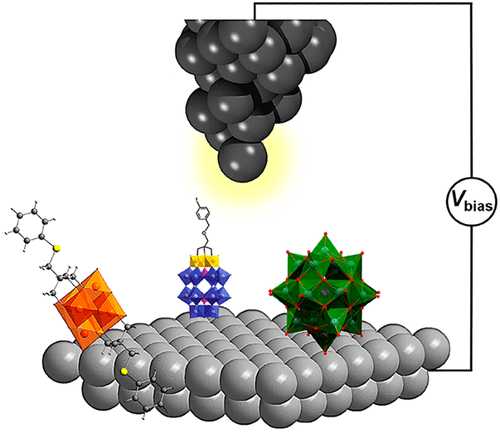当前位置:
X-MOL 学术
›
Acc. Chem. Res.
›
论文详情
Our official English website, www.x-mol.net, welcomes your
feedback! (Note: you will need to create a separate account there.)
Insights from Adsorption and Electron Modification Studies of Polyoxometalates on Surfaces for Molecular Memory Applications
Accounts of Chemical Research ( IF 16.4 ) Pub Date : 2021-08-24 , DOI: 10.1021/acs.accounts.1c00311 Marco Moors 1 , Jonas Warneke 1, 2 , Xavier López 3 , Coen de Graaf 3, 4 , Bernd Abel 1, 2 , Kirill Yu Monakhov 1
Accounts of Chemical Research ( IF 16.4 ) Pub Date : 2021-08-24 , DOI: 10.1021/acs.accounts.1c00311 Marco Moors 1 , Jonas Warneke 1, 2 , Xavier López 3 , Coen de Graaf 3, 4 , Bernd Abel 1, 2 , Kirill Yu Monakhov 1
Affiliation

|
This Account highlights recent experimental and theoretical work focusing on the development of polyoxometalates (POMs) as possible active switching units in what may be called “molecule-based memory cells”. Herein, we critically discuss how multiply charged vanadium-containing POMs, which exhibit stable metal–oxo bonds and are characterized by the excellent ability to change their redox states without significant structural distortions of the central polyoxoanion core, can be immobilized best and how they may work optimally at appropriate surfaces. Furthermore, we critically discuss important issues and challenges on the long way toward POM-based nanoelectronics. This Account is divided into four sections shedding light on POM interplay in solution and on surfaces, ion soft-landing of mass-selected POMs on surfaces, electronic modification of POMs on surfaces, and computational modeling of POMs on surfaces. The sections showcase the complex nature of far-reaching POM interactions with the chemical surroundings in solution and the properties of POMs in the macroscopic environment of electrode surfaces. Section 2 describes complex relationships of POMs with their counter-cations, solvent molecules, and water impurities, which have been shown to exhibit a direct impact on the resulting surface morphology, where a concentration-dependent formation of micellar structures can be potentially observed. Section 3 gives insights into the ion soft-landing deposition of mass-selected POMs on electrode surfaces, which emerges as an appealing method because the simultaneous deposition of agglomeration-stimulating counter-cations can be avoided. Section 4 provides details of electronic properties of POMs and their modification by external electronic stimuli toward the development of multiple-state resistive (memristive) switches. Section 5 sheds light on issues of the determination of the electronic structure properties of POMs across their interfaces, which is difficult to address by experiment. The studies summarized in these four sections have employed various X-ray-scattering, microscopy, spectroscopy, and computational techniques for imaging of POM interfaces in solution and on surfaces to determine the adsorption type, agglomeration tendency, distribution, and oxidation state of deposited molecules. The presented research findings and conceptual ideas may assist experimentalists and theoreticians to advance the exploration of POM electrical conductivity as a function of metal redox and spin states and to pave the way for a realization of (“brain-inspired”) POM-based memory devices, memristive POM-surface device engineering, and energy efficient nonvolatile data storage and processing technologies.
中文翻译:

多金属氧酸盐在分子记忆应用表面的吸附和电子改性研究的见解
本报告重点介绍了最近的实验和理论工作,重点是将多金属氧酸盐 (POM) 开发为可能被称为“基于分子的存储单元”中的有源开关单元。在这里,我们批判性地讨论了如何最好地固定多电荷含钒 POM,它们表现出稳定的金属 - 氧键,并具有改变氧化还原状态的卓越能力,而不会导致中心多氧阴离子核心的显着结构扭曲。在适当的表面上以最佳方式工作。此外,我们批判性地讨论了通往基于 POM 的纳米电子学的漫长道路上的重要问题和挑战。本帐户分为四个部分,阐明溶液中和表面上 POM 的相互作用、质量选择的 POM 在表面上的离子软着陆、表面 POM 的电子修饰,以及表面 POM 的计算建模。这些部分展示了 POM 与溶液中化学环境的深远相互作用的复杂性质,以及 POM 在电极表面宏观环境中的特性。第 2 节描述了 POM 与其反阳离子、溶剂分子和水杂质的复杂关系,这些关系已被证明对所得表面形态有直接影响,其中可以潜在地观察到胶束结构的浓度依赖性形成。第 3 节深入介绍了质量选择的 POM 在电极表面上的离子软着陆沉积,这是一种吸引人的方法,因为可以避免聚集刺激反阳离子的同时沉积。第 4 节详细介绍了 POM 的电子特性及其通过外部电子刺激进行的修改,以开发多态电阻(忆阻)开关。第 5 节阐明了确定 POM 跨界面的电子结构特性的问题,这是难以通过实验解决的。这四个部分总结的研究采用了各种 X 射线散射、显微镜、光谱和计算技术对溶液中和表面上的 POM 界面进行成像,以确定沉积分子的吸附类型、团聚趋势、分布和氧化态.
更新日期:2021-09-07
中文翻译:

多金属氧酸盐在分子记忆应用表面的吸附和电子改性研究的见解
本报告重点介绍了最近的实验和理论工作,重点是将多金属氧酸盐 (POM) 开发为可能被称为“基于分子的存储单元”中的有源开关单元。在这里,我们批判性地讨论了如何最好地固定多电荷含钒 POM,它们表现出稳定的金属 - 氧键,并具有改变氧化还原状态的卓越能力,而不会导致中心多氧阴离子核心的显着结构扭曲。在适当的表面上以最佳方式工作。此外,我们批判性地讨论了通往基于 POM 的纳米电子学的漫长道路上的重要问题和挑战。本帐户分为四个部分,阐明溶液中和表面上 POM 的相互作用、质量选择的 POM 在表面上的离子软着陆、表面 POM 的电子修饰,以及表面 POM 的计算建模。这些部分展示了 POM 与溶液中化学环境的深远相互作用的复杂性质,以及 POM 在电极表面宏观环境中的特性。第 2 节描述了 POM 与其反阳离子、溶剂分子和水杂质的复杂关系,这些关系已被证明对所得表面形态有直接影响,其中可以潜在地观察到胶束结构的浓度依赖性形成。第 3 节深入介绍了质量选择的 POM 在电极表面上的离子软着陆沉积,这是一种吸引人的方法,因为可以避免聚集刺激反阳离子的同时沉积。第 4 节详细介绍了 POM 的电子特性及其通过外部电子刺激进行的修改,以开发多态电阻(忆阻)开关。第 5 节阐明了确定 POM 跨界面的电子结构特性的问题,这是难以通过实验解决的。这四个部分总结的研究采用了各种 X 射线散射、显微镜、光谱和计算技术对溶液中和表面上的 POM 界面进行成像,以确定沉积分子的吸附类型、团聚趋势、分布和氧化态.











































 京公网安备 11010802027423号
京公网安备 11010802027423号